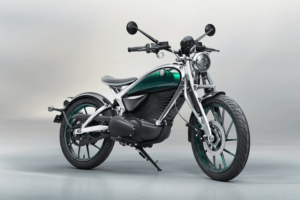Among photographers, the love affair with vintage lenses runs deep. These pieces of optical engineering are not just tools — they’re relics from a different era, each carrying a unique fingerprint of character, quirks, and optical imperfections that breathe life into an image. The swirl of a Helios 44-2, the dreamy glow of a Canon FD, the painterly softness of early Leica glass — these qualities are impossible to fully replicate with modern lenses designed for clinical perfection.
Yet, for all their romance, vintage lenses come with a reality check: manual focus. For many, this is a welcome ritual. The slow twist of a focus ring, the intimate dance of fine-tuning an image until it snaps into place — it can feel meditative, almost sacred. But not every photographer has the luxury of time, nor the desire to miss a fleeting moment because they were micro-adjusting on a moving subject. In the past, this dichotomy forced a choice: embrace the nostalgia and accept the limitations, or stick with modern glass and leave character behind.
Enter Techart and its groundbreaking autofocus adapters — devices that promise to merge the soul of vintage lenses with the technological conveniences of today’s mirrorless cameras. This innovation feels almost alchemical: transforming entirely manual optics into tools that can respond to the quick, precise demands of modern autofocus systems.
The Historical Context: A Journey Through Lens Evolution
Before we dive deeper into Techart’s modern marvel, it’s worth understanding how vintage lenses became beloved cult objects. Throughout the 20th century, camera lenses were purely mechanical marvels. Brands like Zeiss, Leica, Canon, Nikon, and Pentax engineered glass to exacting standards, relying on physical precision rather than software corrections.
These lenses often prioritized character over sharpness. Subtle vignettes, swirling bokeh, and color rendering that leaned toward the poetic rather than the clinical — these “flaws” became signatures. With the advent of autofocus in the late 1980s and 1990s, a wave of new lenses emphasized speed and clarity, driven by emerging sports and wildlife photography demands.
However, by the 2010s, a resurgence of interest in film photography and analog aesthetics reignited love for these older lenses. Photographers began adapting them to modern digital bodies using simple mechanical adapters. While this allowed a new generation to explore their charms, it did nothing to alleviate the need for manual focusing — often difficult on modern EVFs or high-resolution sensors that reveal even the slightest misfocus.
The Techart Solution: A Dream Realized
Techart’s autofocus adapters, including popular models like the Techart Pro LM-EA7, have redefined what is possible. By integrating a moving helicoid mechanism driven by miniature motors, these adapters physically move the entire lens assembly forward and backward to achieve focus. It’s a breathtakingly elegant workaround that transforms a purely manual optic into a pseudo-autofocus lens.
Speed & Accuracy
Let’s get to the most pressing question: does it work? The short answer is yes — with caveats. The Techart adapter’s performance feels reminiscent of consumer autofocus lenses from the 1990s: functional but far from cutting-edge. It’s slow, occasionally noisy, and can sometimes hunt across the focus range if lighting or contrast is poor.
Imagine using a Canon EOS 50mm f/2.5 Macro from the early 2000s: it’s not the fastest, and you wouldn’t take it to a high-speed basketball game. But for portraits, street scenes, or quiet landscape compositions, it’s surprisingly capable. Patience becomes part of the experience, but it is leagues ahead of pure manual focusing when working quickly.
Expanding Creative Horizons
Beyond technical novelty, the Techart adapter represents a philosophical shift. Photographers no longer have to choose between character and convenience. Suddenly, a 40-year-old M-mount Summicron or a rare Russian Helios can track a subject’s eye on a Sony A7 series body. The possibilities for creative exploration expand exponentially.
Moreover, using vintage lenses with modern AF bodies enables hybrid workflows — for example, combining unique analog bokeh with high-resolution digital sensors, precise exposure metering, and real-time electronic viewfinders. Street photographers benefit especially, able to capture candid moments that might have otherwise slipped away.
The Literature and Cultural Context: Romanticizing the “Old”
Writers and visual artists have long romanticized “the old.” In literature, think of Proust’s madeleine or Salinger’s fascination with the past. Photographers mirror this instinct by seeking out old cameras and lenses. There’s a tactile pleasure in engaging with metal and glass crafted decades ago — a sense of continuity with the photographers who once used them.
Vintage lenses embody the Japanese concept of wabi-sabi: the beauty of imperfection and impermanence. Each scratch or yellowed lens element tells a story, adding to the photographer’s narrative.
Yet, modern life often demands speed and efficiency. The Techart adapter feels like a contemporary literary bridge: it allows us to savor the past without wholly abandoning the present. It’s the photographer’s equivalent of listening to vinyl records streamed through Bluetooth speakers — a blend of nostalgia and progress.
Recent Trends: The Renaissance of Old Glass
Over the past few years, there’s been a dramatic rise in YouTube channels, blogs, and Instagram accounts dedicated solely to vintage lenses. Hashtags like #vintagelens, #oldglass, and #manualfocus now attract millions of posts.
This trend reflects a broader cultural yearning for authenticity. In an era saturated with AI-generated images and hyper-sharp, clinically corrected digital photos, imperfections feel refreshing and real. Photographers yearn for images that “feel” rather than simply “show.”
Techart’s adapters have come at the perfect time to support this movement. They’ve made vintage lenses more accessible to younger photographers who may never have owned a film camera but crave the “film look” in a digital workflow. Additionally, these adapters spark a thriving second-hand market for old lenses, rescuing many from dusty attics and transforming them into daily creative companions.
Challenges and Limitations
Of course, no tool is without flaws. The Techart autofocus adapter introduces mechanical complexities and can sometimes become finicky. Compatibility can vary; some heavy or extremely long lenses might not work well due to physical constraints. Battery drain is another consideration since driving the motors requires additional power.
Moreover, using these adapters demands a philosophical acceptance: they are not as precise or fast as modern native AF lenses. In a professional setting where reliability is paramount, they might not always be the best choice.
However, for personal projects, artistic portraits, or explorations into street photography, these limitations often become part of the charm — an invitation to slow down, to engage more deeply with each frame.
When Old Glass Learns New Tricks: The Artistic Impact
The impression of giving “old glass” new tricks goes beyond mere convenience. It represents a philosophical reimagining of what tools can be. By marrying analog character with digital functionality, photographers are empowered to create images that occupy a unique aesthetic space: neither fully modern nor purely retro, but something beautifully hybrid.
Imagine a portrait taken with a 1970s Leica Summilux using eye-detection autofocus on a Sony A7 IV. The subject’s eyes are tack sharp, while the background melts into an impressionistic swirl unique to that lens. The technical execution is effortless, but the emotional impact feels handcrafted and deeply personal.
A New Chapter for Vintage Lenses
The Techart autofocus adapter stands as a symbol of photography’s evolving narrative. It challenges the notion that progress must always replace the old, instead proposing that the past and present can coexist and enrich each other.
When we use vintage lenses today, we engage in a kind of dialogue with photographers of decades past. We see the world through glass that once captured silent streets in 1960s Paris, family portraits in 1970s Tokyo, or endless American highways in the 1980s. By adding autofocus, we don’t erase these histories — we extend them.
No comments yet.








